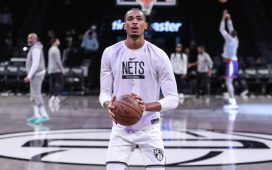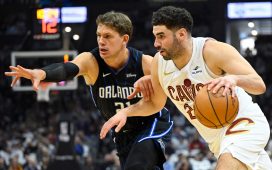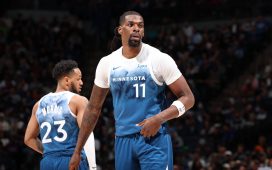SAN FRANCISCO — If the Warriors lose Kevon Looney this offseason because his price is too high, blame none other than assistant coach Dejan Milojević.
Board man gets paid, right?
Get this: Basketball-Reference has Looney grabbing 21.62 percent of the available rebounds when he’s on the floor in these playoffs. That ranks No. 44 all-time for the best rebound rate in a single postseason. Higher than the best postseasons of Kareem Abdul-Jabbar (21.59 percent in 1977) and Tim Duncan (21.38 in 2008). Wilt Chamberlain’s best postseason (21.74 in 1973) is six spots ahead of the Warriors’ starting center.
Moses MaLooney is inhaling rebounds at a rate comparable to legends. But in the 2018 playoffs, Looney grabbed just 12.6 percent of the available boards when he was on the court. It was 12.5 percent in 2019.
So what’s caused the big jump? It isn’t a matter of opportunity. He averages slightly fewer minutes per game this year (19.9) than he did in the 2019 playoffs (20.6). And his first postseason in 2018 wasn’t drastically lower in minutes (18.4). The difference seems to be Milojević, known to the team as Decky. He was hired, presumably, to get the most out of James Wiseman, the No. 2 pick from 2020 whom the Warriors have pegged to be their big man of the future. But Milojević’s impact has shined in Looney’s growth as a rebounder.
“I think this year he became a really elite rebounder,” coach Steve Kerr said of Looney, “and I think Decky, our assistant coach who works with our centers, he’s done a great job in helping Loon in the rebound category.”
Looney’s strides as a rebounder have been instrumental in the Warriors’ run to the 2022 NBA Finals. Golden State is the fifth-best rebounding team in this postseason, in terms of boards per game (44.8) and rebound rate (52.4 percent). The Warriors’ average of 15.3 second-chance points per game in their past two series were vital in getting past Memphis and Dallas.
Boston is a good rebounding team, ranking seventh in rebounds per game (42.8) and rebound rate (49.7 percent) among the 16 playoff teams. The Celtics have won the battle of the boards in every series. But they showed some vulnerability on the defensive glass in the past two series. Against Milwaukee and Miami, Boston allowed an average of 10.9 offensive rebounds per game.
It stands to reason Looney will be vital to either keep the Warriors from getting outrebounded or to exploit a weakness in the Celtics. He’s become a weapon for Golden State because of his penchant for securing extra possessions — capped by his signature moment in Game 6 against Memphis. He grabbed 22 rebounds in the close-out game against the Grizzlies, his 21st an offensive board he tracked down and passed to Klay Thompson for the dagger 3.
Looney, who moments earlier had picked himself off the court like someone who’d fallen asleep on his third job, let out a roar and a flex as Chase Center went bananas. He’d formerly ended games on the bench. But his dominance on the boards has found him on the court at the end of games.
“Rebounding is something that I’ve always enjoyed,” Looney said. “Just getting down in the paint and getting physical and doing the dirty work. … I made a lot of strides this year. I feel like I’ve always been pretty good at it. I always have my moments. But this year I’ve been way more consistent, and really more locked in on it, and that’s been able to make a difference.”
What Milojević, the 45-year-old Serbian basketball lifer, has done is build on Looney’s rebounding talent. Though grabbing boards is often branded as a matter of desire, Milojević believes it’s a skill like any other. He takes pride in saying the big men he’s worked with, most notably Nikola Jokić, are good rebounders. Milojević definitely noticed how Wiseman collected 15 rebounds in 42 minutes over two games in his G League stint.
One of the key elements is positioning. What many would call an intangible nose for the ball is to Milojević simple math big men can learn. They look at film, and data, pay attention to ball trajectory — all with the idea of getting Looney an early beat on where the ball is going.
Milojević was a power forward playing pro ball for Košarkaški klub FMP in Serbia when he saw something that triggered this expertise. He was watching the 1997 NBA finals, featuring the Chicago Bulls, and he kept noticing how Dennis Rodman was moving to a spot before the ball hit the rim. Most players wait for the ball to carom off the rim, see where it is going, then try to go get it. But Milojević noticed Rodman was moving while everyone else was watching.
That began his journey to find the edge Rodman had. A 6-foot-7 power forward who wasn’t exceptionally tall or athletic for his position, Milojević needed an edge. He was strong, but the rest would have to come from strategy. Now, he teaches anticipation and how to predict where the ball is going.
Looney has been studying the probabilities based on where each shot is taken. He’s gotten adept at reading how strong the ball was shot, and how soft, and how it might bounce.
“If you look at the trajectory of the ball,” Milojević said, “you can predict and anticipate. Did they shoot it stronger, or weaker, so you can relocate. And, of course, if you hustle, you can do all these things.”
And then there is Looney’s favorite part: banging. Milojević teaches him how to strategically box out, how to initiate contact to keep a would-be rebounder grounded. They discuss angles, moves to get better positioning and how to take advantage of Looney’s 7-foot-4 wingspan.
“For example, if you are in contact with somebody, they can’t jump,” Milojević said. “This is how you can fight the high fliers. … Rebounding is a skill like everything else is in basketball. Most people think it’s effort. … Nothing can be done without effort. But it’s not, like, enough.”
Milojević said outside of the principles he shares with every player he works with, his approach is to collaboratively figure out how to make the individual player a better rebounder. He can’t do that with a cookie-cutter approach. Milojević uses film, dialogue, analytics and the eye test to figure out what each player needs to improve on the boards.
Looney took to the coaching and, coupled with his desire to get better on the boards, put together a career year on the boards. His 7.3 rebounds per game during the regular season was a career-high. He and Andrew Wiggins are tied for the most offensive rebounds in the postseason (42). Looney’s 208 offensive rebounds were the 12th-most in the NBA during the regular season.
One of the prominent images of this Warriors’ run is Looney chasing down board after board. It gives life to the Warriors’ offense. It sets up open looks for the shooters. It demoralizes opponents. If he can keep it up against Boston, it would go a long way toward helping the Warriors land a fourth title.
And Looney’s value would be obvious and tangible.
“He’s working hard,” Milojević said. “He is a highly coachable guy, trying to do whatever is asked of him. I can see that we all enjoy having him. I enjoy working with him.”
(Photo of Kevon Looney: Kyle Terada / USA Today)








